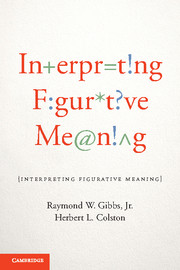Book contents
- Frontmatter
- Contents
- 1 Introduction
- 2 Identifying Figurative Language
- 3 Models of Figurative Language Comprehension
- 4 Interpreting Specific Figures of Speech
- 5 Indeterminacy in Figurative Language Experience
- 6 Factors Shaping Figurative Meaning Interpretation
- 7 Broadening the Scope of Figurative Language Studies
- References
- Index
1 - Introduction
Published online by Cambridge University Press: 05 June 2012
- Frontmatter
- Contents
- 1 Introduction
- 2 Identifying Figurative Language
- 3 Models of Figurative Language Comprehension
- 4 Interpreting Specific Figures of Speech
- 5 Indeterminacy in Figurative Language Experience
- 6 Factors Shaping Figurative Meaning Interpretation
- 7 Broadening the Scope of Figurative Language Studies
- References
- Index
Summary
Figurative language generally refers to speech where speakers mean something other than what they literally say. Consider a situation in which Harriet says to a friend, “My marriage is an icebox.” Most people recognize that Harriet intends to communicate something negative about her marriage, such as it is not emotionally affectionate or sexually passionate. How listeners arrive at these metaphorical meanings is a topic of considerable debate within both the humanities and cognitive science. One widely held belief is that metaphorical language must be more difficult to understand than plain, literal speech, precisely because metaphors, like all kinds of figurative language, are ornamental and deviate from literal thought. A standard way to assess this idea is to measure the amount of time it takes listeners, or readers, to comprehend figurative (in this case metaphorical) utterances compared to roughly equivalent literal speech.
The results of dozens of studies present a complex picture on this issue. Although, when seen in isolation, metaphorical utterances generally take longer to understand than literal ones, figurative speech can often be understood as quickly as literal speech when encountered in realistic discourse contexts (Gibbs, 1994, 2011 for reviews). This conclusion is especially true for more familiar, conventional figurative language, such as idioms (e.g., “kick the bucket”), stock metaphors (e.g., “John is a tiger”), conventional ironies (e.g., “A fine friend you are”), and certain indirect speech acts (e.g., “Can you pass the salt?”). Some scholars argue, nonetheless, that novel figurative language, such as creative metaphors, will always require additional cognitive effort to understand compared to that needed to process nonfigurative speech. The extra time needed to comprehend figurative language is often assumed to reflect initial processing of a word's (or an entire phrase's) literal or semantic meaning, with context having a guiding role later in the interpretation process.
- Type
- Chapter
- Information
- Interpreting Figurative Meaning , pp. 1 - 14Publisher: Cambridge University PressPrint publication year: 2012



